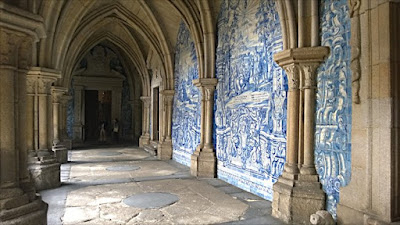Further to my last post (on how we might bear witness publicly, yet discreetly and beautifully through tiled images cemented into buildings), readers have been coming forward with interesting and useful points. For the following I woud like to thank particularly, Raven W.
First the interesting - a number pointed out that Portugal has many blue and white ceramic tiled images. You can see many of these if you do an image search on 'Portuguese religious tile murals'.
As I dug further I found this photograph of an extraordinary mural on the wall in the town of Avente.
There are charming little decorative details as well. Remember that these patterns reflect a geometry that echoes the mathematical description of the beauty of the cosmos. When we get this right it is decoration with purpose - subtly but powerfully raising people's spirits to God through cosmic beauty so that they might be receptive to the Word.
I then decided to look further and explicitly search for Spanish architecture influenced by the Islamic art, as a style called Mujedar. I found these in the cathedral of Santa Maria de Teruel, in the town of Teruel:
This external adornment is so important in that everybody sees it. If it is done beautifully enough they will not object, I believe. The onus is on us, artists, architects, patrons, that is everybody, to start thinking about this and looking for opportunities for cosmic beauty in every aspect of our environment. (If you want to know more about the theory behind these designs, then I have just created a course as part of Pontifex University's Master of Sacred Arts program called The Mathematics of Beauty. This is an extended presentation of the theory introduced in my book, The Way of Beauty.)
Some of you may be wondering where we can get such tiles today? (Now we come to the useful!) I am not in the building trade so there is probably a lot more than I am aware of. But here are some ideas.
Patterns that reproduce the Victorian neo-gothic church floors are produced today for kitchens and bathrooms. I saw a shop on Chiswick High Road in West London, that had William Morris designs in the shop window. These floor designs began as renovations of English gothic floors, such as the 13th century, Westminster pavement in Westminster Abbey by Victorians such as George Gilbert Scott. I would as happily use these tiles in the sanctuary of a church as in an external walkway:
...and here is a detail of St Albans Cathedral floor, renovated in the 1880s:
For the figurative religious imagery, it had occurred to me that if you can order cups with personalized messages on them online, it has to be as easy to reproduce religious imagery on ceramic now as it is to put 'World's Greatest Mom' on a mug! Sure enough, a reader referred me to this Italian company that offers Catholic religious images through Etsy and they do mail order. Here is a ceramic tile image of the Virgin at Prayer by Sassoferrato:
So there are ways we can start to think about this.
It can be done well or badly - we still need to take care that we don't put this together to create kitsch, but as long as we are aware of that we have a chance. And as GKC said - if something is worth doing, it's worth doing badly!
We finish with something done well. A cloister in the cathedral at Porto, Portugal.











